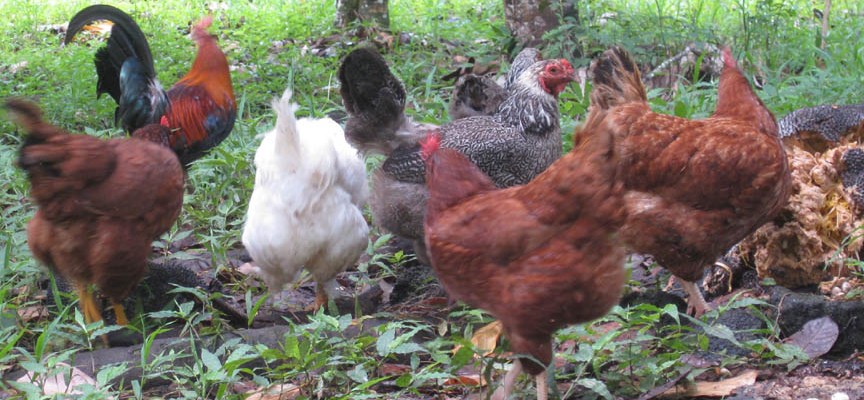
Momma hen with chicks in coconut
Perhaps you’ve seen the video on You Tube of a woman ranting about chicken’s being the starter animal to having a farm. She says before you know it you’ll want goats so you can have feta on your eggs. She continues, then you’ll want to get a cow to have a glass of fresh milk to go with your breakfast. This woman really knows what she’s talking about because that’s exactly what happened to us.
When we first moved to the farm, we wanted chickens, of course. We were uncertain as to how to go about getting them. We read a book about chickens and I guess that’s a good place to start. Still we needed the hens. We thought about mail order chicks. Since it was winter–even in Hawaii it gets chilly at night–we didn’t know how we were going to keep them warm. At the time, we didn’t have enough power to even run a light bulb all night. Being new to off-grid living and we had very little solar power back then and even less knowledge about getting more.
We went to the feed store in town and by chance they had two full-grown Rhode Island red hens for sale. The man behind the counter said that they never get full grown hens. It was our lucky day! These were our starter hens.
We named them Franny and Moonie and built them a coop with a fenced run around it. I remember how excited we were when we got our first eggs. Things were looking up but they were not perfect. In order to be sustainable and get our own chicks, we needed a rooster.

The Rooster, Fabio
A rooster’s true purpose is to protect the hens, alert them to dangers, keep other roosters away, and to jump on the hens to mate as often as possible. They’re tricksters as well and I’ve seen them pretend to find a treat in the grass if just to lure over a hen.
Miraculously, one day we started hearing a rooster crowing on our farm. We didn’t really know where he came from but by his morning crowing we figured out where he was roosting. We crept up on him one night and grabbed him out of a large mango tree. We put him in a pillow case so we could carry him to the coop thus leaving us unscathed from the spurs on his feet we read about. Oh, that poor fellow what an awful cry he made when captured! Soon, however, he was happily escorting the ladies around and seemed happy to pretend to find food. We named him Arthur.
Arthur disappeared almost as fast as he arrived and one day he was just gone. We found out later he returned to his farm of origin to do battle again with the reigning rooster there. I don’t think he won but he never returned. Later, I got a call from another neighbor who had an extra rooster name Oreo, so we took him in. Oreo had a long life on the farm until one day when he was also challenged by a younger, stronger rooster named Fabio.
One thing you will learn about living on a farm is that you can’t have too many roosters to hens and they must be culled or they’ll see to it themselves in a battle to the death.

The Rooster, The Cisco Kid
I knew I was past the squeamishness of thinning the roosters out on my farm when my friend asked me if I’d take on her problematic rooster. One that crows very loudly and doesn’t stop, she said. At 4:30 a.m. that morning her neighbors had cried out, “Your rooster is ruining my life!” The funny thing about this story is that I soon put two and two together that the people complaining and rooster’s owners were both close friends of mine. Now I had to take him.
I took on that rooster, he was a muscular rooster with beautiful plumage. I was hoping that all stories were somewhat exaggerated. I am a farmer, rooster’s crowing doesn’t bother me. At about 4:00 in the morning he started to crow and didn’t stop until 10:00 am when I detached his head from his body. I made our favorite rooster farm dish, green papaya chicken.
Our next farm animals were two sheep we traded for a telephone line. But that’s another story. A hui ho!
